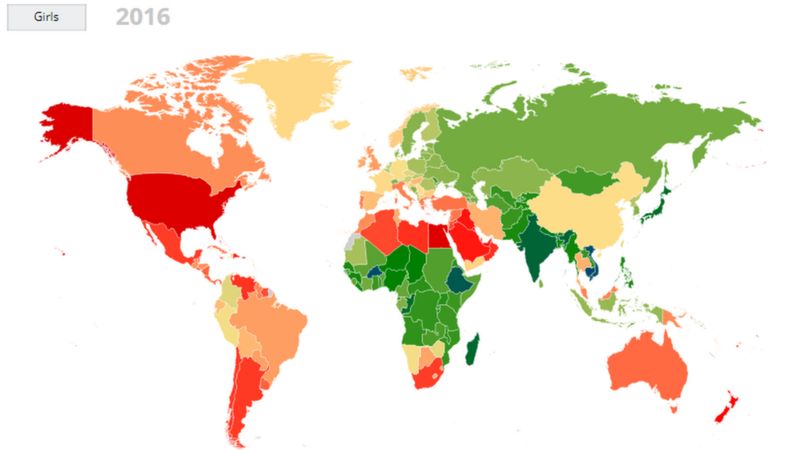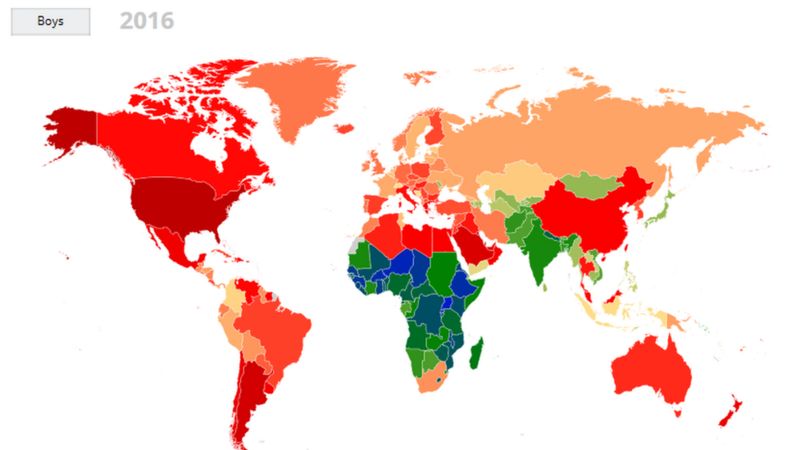Introduction
Obesity is a complex and important issue concerning every country on earth. Due to a variety of factors, weight gain is a problem for more and more people each year. The trends are especially concerning when taking into account the prevalence of obesity in children. Commonly occurring when a child exceeds the healthy weight amount for their age and height, it is extremely harmful to the development of a young body (1). While it is argued that obesity is primarily a personal, private, issue, this paper will demonstrate that the condition is harmful to society on both the individual and the global levels. The report aims to speak about the development of obesity in children specifically. This paper will touch upon the main causes of obesity, its spread throughout the world, the major effects of the condition, and ways of prevention.
Spread and reasons
Childhood obesity is a global issue, affecting each country differently. Industrial development, culture, and the state of the economy all affect how much child obesity affects kids in a particular country. An article by the BBC news uses world map illustrations to highlight how different territories are affected by the condition.


With male and female children being separated, the maps show that childhood obesity spreads among males much more widely and that countries such as Canada and the U.S. are especially affected. Statistics show that more than 18% percent of children and adolescents in America suffered from obesity, with most of the victims being aged 12 to 19 (3). There are some reasons for developing obesity in children, including, but not limited to: lifestyle choices, lack of exercise, unstable family life, phycological issues, socioeconomic factors, hormonal issues, and other factors (4). Many of these issues do not directly cause obesity in children but can become a significant contributing factor under certain circumstances.
Effects
Childhood obesity has major implications for the individual, both long- and short-term. Physical consequences include developing type-2 diabetes, increasing the chances of heart disease (4). Obesity contributes to higher cholesterol levels in the blood and elevated blood pressure as well, putting the person at a higher risk of stroke. Trouble falling and staying asleep, asthma, and many other connected diseases can also be the result of obesity in children (4). The physical implications of obesity are not the only side of the issue, as psychological and social complications also often occur. Overweight children are often subject to bullying, as their peers consider such kids to be out of the norm, which severely impacts an individual’s self-esteem (4). Rough treatment can lead to shyness, trouble expressing one’s emotions, depression, and sometimes even suicidal ideations. Excess weight can also contribute to behavioral problems and trouble learning, as obese children can have a harder time communicating with their classmates (4). This array of factors makes obesity an issue that affects most facets of a child’s life.
Prevention
There are some steps a concerned parent of a professional can take to prevent a child from being overweight. The most important thing in such an endeavor is consistency, establishing healthy routines and habits for the young. Limiting the child’s sugary drinks and food consumption, as many of them can contribute to obesity (4). Providing a child with a healthier alternative like fruit and vegetables is crucial to balancing their nutritional intake. Forming regular eating habits and dining together as a family can help the parents to monitor their child’s diet and regulate its timing (4). Eating out is another risk factor for young children, and guardians need to carefully access how much their child consumes food at fast-food restaurants (4). Overall, a parent needs to keep an eye on their offspring’s food choices, promoting healthy products instead of sugar-filled junk food. Although food consumption control is an important aspect of the prevention process, other approaches are also highly relevant. Promoting active family time and exercise can aid the child in staying in shape, and regulating the amount of sleep they get is beneficial to their balanced growth and development.
Discussion
Through presented research, it has been deduced that childhood obesity is an issue that concerns people on all levels of society. With the widespread availability of processed food and the rise in popularity of digital technology, the youth are becoming more susceptible to being overweight each day. Expectedly, the leading nations are especially affected by this problem, with America having the highest rates of obesity on the planet. It is scientifically proven that obesity during childhood poses a severe danger to the mental and physical well-being of an individual with many having to suffer from long-term conditions. Many previous studies have examined the effects of childhood obesity in more detail, one even citing it as a major risk factor for mortality (5). Other specific studies also bring attention to the emotional turmoil experienced by obese children, understandably experiencing bullying, and social isolation more than others (6). Exploring the leading causes for excess weight in children and encouraging the widespread effort to combat it is necessary for effectively counteracting the issue. While this paper is effective in collecting and presenting available data, it lacks new information to further the discussion, which may be considered a major limitation. It is suggested that specialists in the field conduct more research into effective prevention and treatment methods for children.
Conclusion
Overall, child obesity is a serious issue that needs constant attention from both the general population and the government at large. The development of children is especially important to the proper functioning of society, as younger generations slowly replace their ancestors. The need to raise children to be healthy, happy, and confident is what primarily drives the incentive to counteract obesity. With many major first-world countries being affected in a major way, the need to enact measures to stop the spread of obesity is higher than ever. A condition that has significant implications on the physical and mental well-being of children has to be combatted by the joined efforts of society and the individual. By securing the health of children, humanity ensures its continued longevity, innovation, and prosperity.
References
- Centers for Disease Control and Prevention. Childhood Obesity Causes & Consequences [Internet]. 2020 Web.
- Roberts M. Child and teen obesity spreading across the globe [Internet]. BBC News. BBC; 2017. Web.
- Childhood Obesity Facts [Internet]. Centers for Disease Control and Prevention. Centers for Disease Control and Prevention; 2019. Web.
- Childhood obesity [Internet]. Mayo Clinic. Mayo Foundation for Medical Education and Research; 2018.Web.
- Maffeis C, Tatò L. Long-Term Effects of Childhood Obesity on Morbidity and Mortality. Hormone Research. 2001;:42–5.
- Paxton, H. The effects of Childhood Obesity on Self-Esteem. Theses, Dissertations and Capstones. Paper 140. 2005.